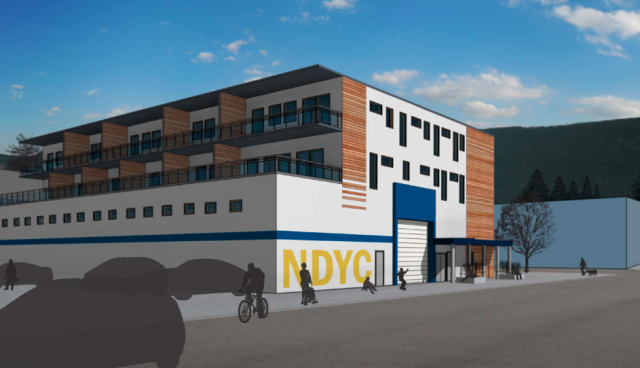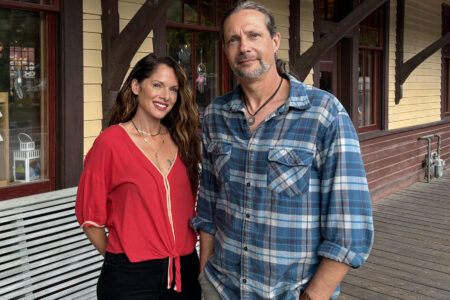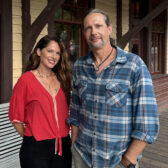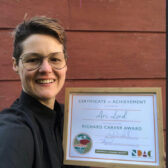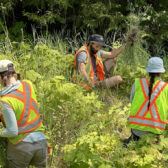New study explores building housing on Youth Centre roof
The roof on the Nelson and District Youth Centre (NDYC) leaks and it is not repairable. So if the city, which owns the building, is going to spend the estimated $100,000 required to replace it, why not add two storeys of housing on top, and find a way to fund it?
Former city councillor Paula Kiss of the Cascadia Green Building Council and local architect Lukas Armstrong of Cover Architecture posed that question to council on Monday night.
Last year the Cascadia Green Building Council, a non-profit organization, got a grant from the Columbia Basin Trust and hired Cover Architecture to do a feasibility study at no cost to the city.
The study, attached below, concludes that it would be possible to add 12,000 square feet of housing in two storeys on top of the NDYC building. This could be broken down into anywhere from 19 to 33 suites, depending on their size, and it could include public and private roof gardens.
“We are proposing that the city has an empty lot here,” Kiss told council. “This could be considered a developable lot.”
The estimated cost would be $200 per square foot or $2.4 million—up to $1 million less than the cost of constructing the building from the ground up.
While doing the study, Cover Architecture discovered several problems with the current building in addition to the leaky roof, the main one being a fire safety issue related to an interior stairwell. The report proposes these could be dealt with during construction of the additional stories, resulting in reduced youth centre renovation costs.
Kiss said the required structural upgrade to the existing building is likely equal to the costs of a foundation for a new building.
The feasibility study includes an engineering report stating that existing soil conditions would allow for two storeys being added to the building.
Kiss and Armstrong said they had no concrete suggestions as to the funding or development model, but Kiss suggested council could take the report, develop some parameters around it, perhaps including the identification of a particular demographic of housing needs, and put out a call for expressions of interest from non-profits or private interests who might want to partner with the city.
They suggested that if the city decided the housing would be for a particular demographic, for example seniors or at-risk youth, then that population could be at the table when further design work was done.
Asked by Councillor Valerie Warmington what could be done about the current difficulties in heating the NDYC, Armstrong said insulation could be added during construction and Kiss said two stories of heated space would effectively insulate the current NDYC roof.
Asked by Councillor Bob Adams whether the current water and sewer service to the building would be enough to service the new units, Armstrong said this was not covered by the study.
“The thing that is missing is parking spaces,” said Councillor Robin Cherbo.
“This is where the city could create some parameters,” said Kiss, “around the type of agency or organization they would want to partner with. You may want to have a certain amount of parking that would be provided offsite, or you could partner with an organization that caters to people that tend not to have vehicles.”
“We could do something like the dorms at Selkirk,” said Cherbo, “those types of partners and infrastructure grants. I think this is a good start to working on getting housing units in the city for people on low incomes.”
Cherbo also suggested that it could be tied in with plans for a district energy system.
Kiss concluded with a statement of support for the NDYC.
“It is not just because I was on the NDYC advisory committee for three years, but I would like to suggest to council that the Youth Centre is the highest and best use for this building. It is important for the Youth Centre to stay downtown and somewhere accessible. There has been a lot of banter about other things that could be built on this location, but the Youth Centre is a valuable asset and potentially adding housing is an excellent thing to consider.”
Council took the report as information and made no decision about it, but there seemed to be a consensus that it would play a role in future discussions and decisions about housing and the NDYC.
The presentation to city council, and the study itself, are attached below.
Related story in The Nelson Daily:
Up to 200 housing units needed for vulnerable groups in Nelson, says new housing report (December 1, 2014)


